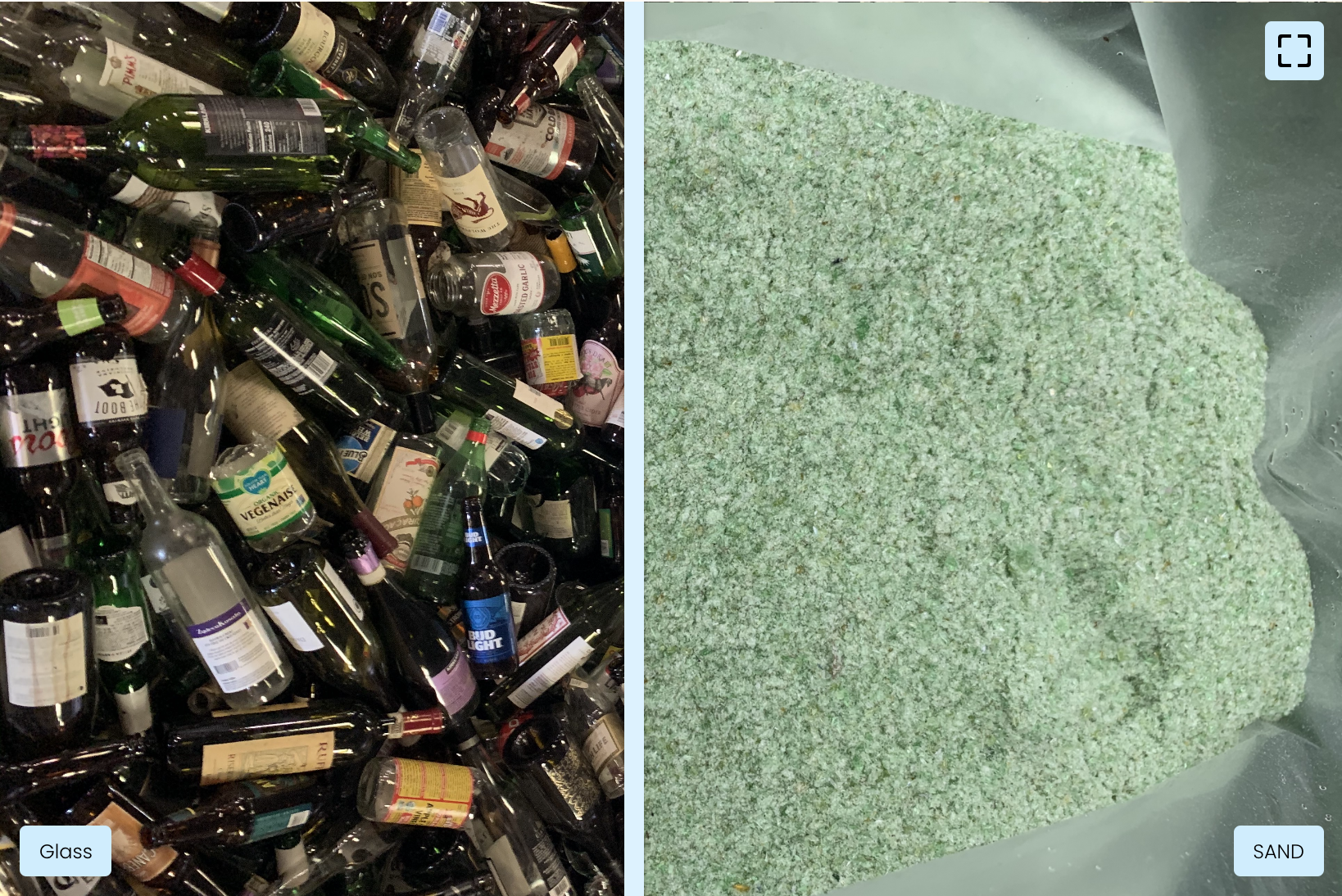 Started by Max Steitz and Franziska Trautmann out of frustration about the lack of glass recycling options in New Orleans, Glass Half Full strives to make a difference by turning glass waste into usable sand. This sand can be used for many purposes such as coastal restoration efforts, flood and disaster relief prevention, glass cullet, and new glass products.
Started by Max Steitz and Franziska Trautmann out of frustration about the lack of glass recycling options in New Orleans, Glass Half Full strives to make a difference by turning glass waste into usable sand. This sand can be used for many purposes such as coastal restoration efforts, flood and disaster relief prevention, glass cullet, and new glass products.
Glass Half Full has two different methods of glass collection, one via a pickup service and the other through a drop-off service at their facilities. Once the glass is collected, they begin the process of conversion to sand. Once the glass products arrive at the facility, it goes through a series of processing systems that crush the glass and pulverize it to create the sand that is then separated into different sizes with specific utilizations.
Five different sizes of sand are created. On the two ends of the spectrum, they have their most fine product of super absorbent sand, making it very effective for disaster relief sandbags. On the other end is the coarsest sand where water can easily get through, which can be very effective for irrigation and agriculture purposes. This coarse sand takes millions of years to decompose, meaning that it’s not breaking down easily, which is important for agriculture and irrigation use. The coastal restoration efforts utilize mainly the sizes in the middle, excluding the fine powder sand. The Glass Half Full sand is outperforming a lot of the dredge materials in coastal restoration efforts because it’s coarser and won’t wash away as easily.

Sand and glass cullet made by Glass Half Full sorted into jars to be redistributed.
Fighting the coastal erosion crisis has been the nonprofit’s ultimate goal from the outset of the organization. In partnership with Tulane University and the National Science Foundation, they study the feasibility of using the sand for coastal restoration and erosion protection. This process takes significant research and development to ensure the process is safe and doesn’t result in unintended consequences.
Several multi-billion-dollar projects are held up in Louisiana because of a lack of dredge. This dredging process is when large vessels go into waterways and suck up the sand at the bottom of the channel. They then bring the sand that is extracted back to the shore. This process of dredging is very environmentally costly because in sucking up the sand from the bottom of waterways; they are also sucking up all the other stuff with the sand, which is destroying the ecosystem that exists from the ground up.

Photo was taken from glasshalffullnola.org
Glass Half Full is aiming to be a more sustainable alternative to the industry standard that is dredge or extracted sand. Using the Glass Half Full sand instead of the dredged sand alternative, many values are added. The four main value adds are the sand is greener, cleaner, safer, and more uniform. The Glass Half Full sand is greener because its process is diverting glass bottles from our landfills. The sand is also cleaner because dredged sand can be filled with many other materials at the bottom of waterways. The sand is also safer because it doesn’t cause diseases like silicosis, as with normal sand. Lastly, the sand is more uniform because glass sand is the same throughout the world.
In contrast, regular sand is not, making coastal restoration research and development harder because of the variation in different places. The ethical and sustainable sand that Glass Half Full uses provides an alternative to the current harmful and costly sand extraction techniques.
 NOLAbeings Multimedia artist Claire Bangser created NOLAbeings as a portrait-based story project that marries...
NOLAbeings Multimedia artist Claire Bangser created NOLAbeings as a portrait-based story project that marries...  Voodoo in New Orleans: Reviving history: New Orleans fortune telling This article takes a deep dive into the history of Voodoo in New Orleans, its hybridization with Catholicism, and its present-day place in the city's culture. The author visits fortune-tellers in the French Quarter, using their guidance as a tool for introspection rather than a deterministic predictor of the future. Through her experiences in New Orleans, the author feels a mystical connection to both the past and the future.
Voodoo in New Orleans: Reviving history: New Orleans fortune telling This article takes a deep dive into the history of Voodoo in New Orleans, its hybridization with Catholicism, and its present-day place in the city's culture. The author visits fortune-tellers in the French Quarter, using their guidance as a tool for introspection rather than a deterministic predictor of the future. Through her experiences in New Orleans, the author feels a mystical connection to both the past and the future. 